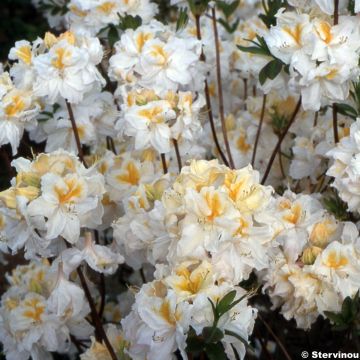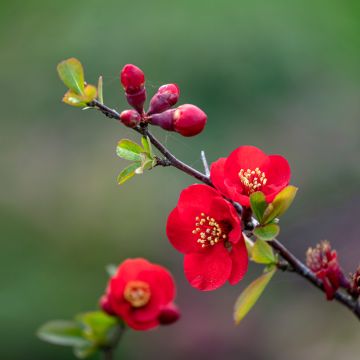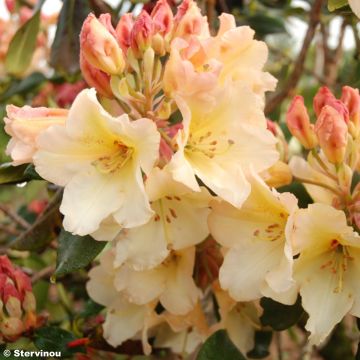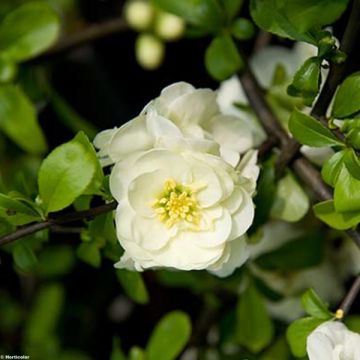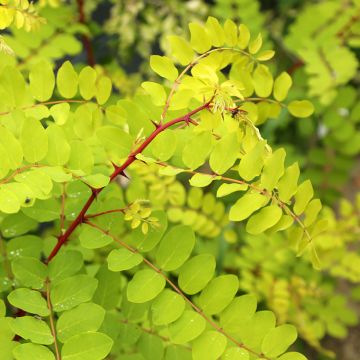

Azalée de Chine - Azalea (Rhododendron) x viscosum Rosata
Chinese Azalea Rosata
Rhododendron (Azalea) x viscosum Rosata
Chinese Azalea
Why not try an alternative variety in stock?
View all →This plant carries a 24 months recovery warranty
More information
We guarantee the quality of our plants for a full growing cycle, and will replace at our expense any plant that fails to recover under normal climatic and planting conditions.
From €5.90 for pickup delivery and €6.90 for home delivery
Express home delivery from €8.90.
Does this plant fit my garden?
Set up your Plantfit profile →
Description
The 'Rosata' Chinese Azalea, derived from Rhododendron viscosum, is a beautiful bush with relatively slow growth and deciduous foliage composed of small leaves of a bright green. This Azalea is particularly appreciated for its superb semi-late pink flowering, delicately scented. Very hardy, this bush will thrive in a gently sunny or semi-shaded position, in slightly moist acidic soil. It is an excellent choice for a small garden that it will enliven with its joyful flowering.
Azaleas are now classified as Rhododendrons, members of the Ericaceae family, which includes many ornamental genera (Kalmia, Leucothoe, Erica, Calluna, Oxydendrum, Gaultheria, Pieris...) as well as some small fruits (Vaccinium: blueberry, Arbutus: bearberry, Arctostaphyllos uva-ursi: bear grape). The Rhododendron genus is very rich in species (about a thousand). It includes evergreen and deciduous varieties, from miniature bushes to 15m (49ft 2in) tall trees. Their flowering covers almost the entire range of colours thanks to the numerous horticultural varieties available on the market.
Rhododendron viscosum is a species native to the eastern United States, where it is indigenous to a large geographical and climatic area, ranging from the cold New England (which explains its great hardiness down to -24°C (-11.2 °F), or even lower) to the subtropical Florida (which gives it one of its common names, Swamp Azalea). This amazing range is not its only peculiarity, as it blooms in June-July, which is very unusual, producing flowers with viscous tubes (hence its species name viscosum).
Rhododendron 'Rosata' is a horticultural hybrid obtained in 1938 by Batavus Bernardus Cornelis Felix, a breeder from the Netherlands. 'Rosata' is the result of a cross between the species, Rhododendron viscosum, with whitish flowers, and Koster's 'Brilliant Red', a variety of Azalea mollis (Rhododendron mollis) with orange-red flowers. This already old variety is still available on the market thanks to its ornamental qualities. It has even received a distinction from the highly renowned Royal Horticultural Society of England (an RHS Award of Garden Merit). It is a bush with relatively slow growth, growing only about 10-12cm (3.9-4.7in) per year. After 10 years of planting, it will reach approximately 1.40m (4ft 7in) in all directions, and can then grow slightly taller (1.80m (5ft 11in) high by 1.50m (4ft 11in) wide). Its deciduous leaves are quite small, about 5cm (2in) long, obovate (wider near the tip than at the base) and of a bright green. Its 4 to 5cm (1.6 to 2in) diameter flowers are grouped in clusters of 7 to 11 flowers, a pretty pink colour, with a darker central vein on each of the 5 petals. The reverse side of the petals is also darker, as are the flower buds before they bloom. All together, they create a joyful spring symphony in May and until June, succeeding the early flowering deciduous Azalea varieties.
In cool and dim climates, this Rhododendron can grow in the sun, but elsewhere, it is preferable to plant it in partial shade. It mainly fears drought and will appreciate cool and even moist soils, preferably acidic (pH 4.5 to 6) or neutral (by enriching the planting hole with heather soil), but definitely not alkaline.
The 'Rosata' Azalea will be ideal to celebrate the end of spring in a heather bed. You can create a romantic scene by associating it with white flowers, such as those of Kalmia latifolia 'Elf', a charming dwarf Mountain Laurel, whose narrow dark green foliage enhances the white corollas that bloom at the same time as 'Rosata''s pink clusters. To frame 'Rosata''s flowering, you will have plenty of choices among the countless varieties of Rhododendrons that flower before it, in April, and as you move towards summer, you will obviously have the abundance and generosity of Hydrangeas, with white, pink, red, purple, or blue flowers, often of large dimensions. But there is a much less known plant that deserves a place in your garden, behind 'Rosata', it is Oxydendron arboreum, or Sorrel Tree. This large bush indeed has it all: a long-lasting flowering in July-August, consisting of long clusters of small cream-white bells, and foliage that turns red and orange in autumn, rivaling with Witch Hazels and other champions of the genre!
Divided into 2 horticultural groups, the Rhododendron genus includes, on one hand, Azaleas, Chinese and Japanese, with small evergreen or deciduous leaves, equipped with 5 stamens per flower, and on the other hand, Rhododendrons, with ample, evergreen, and glossy leaves, whose flowers have more than 10 stamens. Although highly debatable from a botanical point of view, this classification is still widely used by horticulture professionals.
Report an error about the product description
Chinese Azalea Rosata in pictures


Plant habit
Flowering
Foliage
Botanical data
Rhododendron (Azalea)
x viscosum
Rosata
Ericaceae
Chinese Azalea
Cultivar or hybrid
Other Chinese Azalea
Planting and care
Plant Rhododendron 'Rosata' in a sunny, non-burning exposure in the north, in semi-shade elsewhere in the UK, protected from cold and drying winds, in a fresh, humus-rich and light, acid-loving soil. Like all plants of the heath family, it does not tolerate limestone soils or heavy soils saturated with water in winter.
Dig a hole three times larger than the pot. Soak the root ball in non-limestone water for fifteen minutes, and plant the bush at the collar level, in a mixture composed of 1/4 peat, leaf compost, gravel or pumice and loam. Water generously and keep the soil moist during summer.
Azaleas and Rhododendrons have a shallow root system. As a result, they are susceptible to long periods of drought. This is why a humus-enriched soil and abundant watering during dry periods are recommended. In addition, this root system is not very strong, which is why it is essential to lighten heavy soils with draining materials (gravel, pumice, clay pellets) at planting.
Then apply a mulch of crushed pine bark at the base of the bush every spring to keep the soil cool while maintaining an acidic pH. Maintenance consists of removing faded flowers in summer with pruning shears and cleaning dead branches. Azaleas and Rhododendrons can sometimes be attacked by weevils that eat the edges of leaves and rootlets, as well as the infamous "rhododendron budworm" which does not often cause severe damage. Yellowing of the leaves (chlorosis) in Rhododendrons indicates poor assimilation of iron in the soil and leads to premature death of the plant. While limestone is often the cause, poorly drained soil or a deeply planted root ball can also explain the phenomenon.
Planting period
Intended location
Care
This item has not been reviewed yet - be the first to leave a review about it.
Spring-flowering shrubs
Haven't found what you were looking for?
Hardiness is the lowest winter temperature a plant can endure without suffering serious damage or even dying. However, hardiness is affected by location (a sheltered area, such as a patio), protection (winter cover) and soil type (hardiness is improved by well-drained soil).

Photo Sharing Terms & Conditions
In order to encourage gardeners to interact and share their experiences, Promesse de fleurs offers various media enabling content to be uploaded onto its Site - in particular via the ‘Photo sharing’ module.
The User agrees to refrain from:
- Posting any content that is illegal, prejudicial, insulting, racist, inciteful to hatred, revisionist, contrary to public decency, that infringes on privacy or on the privacy rights of third parties, in particular the publicity rights of persons and goods, intellectual property rights, or the right to privacy.
- Submitting content on behalf of a third party;
- Impersonate the identity of a third party and/or publish any personal information about a third party;
In general, the User undertakes to refrain from any unethical behaviour.
All Content (in particular text, comments, files, images, photos, videos, creative works, etc.), which may be subject to property or intellectual property rights, image or other private rights, shall remain the property of the User, subject to the limited rights granted by the terms of the licence granted by Promesse de fleurs as stated below. Users are at liberty to publish or not to publish such Content on the Site, notably via the ‘Photo Sharing’ facility, and accept that this Content shall be made public and freely accessible, notably on the Internet.
Users further acknowledge, undertake to have ,and guarantee that they hold all necessary rights and permissions to publish such material on the Site, in particular with regard to the legislation in force pertaining to any privacy, property, intellectual property, image, or contractual rights, or rights of any other nature. By publishing such Content on the Site, Users acknowledge accepting full liability as publishers of the Content within the meaning of the law, and grant Promesse de fleurs, free of charge, an inclusive, worldwide licence for the said Content for the entire duration of its publication, including all reproduction, representation, up/downloading, displaying, performing, transmission, and storage rights.
Users also grant permission for their name to be linked to the Content and accept that this link may not always be made available.
By engaging in posting material, Users consent to their Content becoming automatically accessible on the Internet, in particular on other sites and/or blogs and/or web pages of the Promesse de fleurs site, including in particular social pages and the Promesse de fleurs catalogue.
Users may secure the removal of entrusted content free of charge by issuing a simple request via our contact form.
The flowering period indicated on our website applies to countries and regions located in USDA zone 8 (France, the United Kingdom, Ireland, the Netherlands, etc.)
It will vary according to where you live:
- In zones 9 to 10 (Italy, Spain, Greece, etc.), flowering will occur about 2 to 4 weeks earlier.
- In zones 6 to 7 (Germany, Poland, Slovenia, and lower mountainous regions), flowering will be delayed by 2 to 3 weeks.
- In zone 5 (Central Europe, Scandinavia), blooming will be delayed by 3 to 5 weeks.
In temperate climates, pruning of spring-flowering shrubs (forsythia, spireas, etc.) should be done just after flowering.
Pruning of summer-flowering shrubs (Indian Lilac, Perovskia, etc.) can be done in winter or spring.
In cold regions as well as with frost-sensitive plants, avoid pruning too early when severe frosts may still occur.
The planting period indicated on our website applies to countries and regions located in USDA zone 8 (France, United Kingdom, Ireland, Netherlands).
It will vary according to where you live:
- In Mediterranean zones (Marseille, Madrid, Milan, etc.), autumn and winter are the best planting periods.
- In continental zones (Strasbourg, Munich, Vienna, etc.), delay planting by 2 to 3 weeks in spring and bring it forward by 2 to 4 weeks in autumn.
- In mountainous regions (the Alps, Pyrenees, Carpathians, etc.), it is best to plant in late spring (May-June) or late summer (August-September).
The harvesting period indicated on our website applies to countries and regions in USDA zone 8 (France, England, Ireland, the Netherlands).
In colder areas (Scandinavia, Poland, Austria...) fruit and vegetable harvests are likely to be delayed by 3-4 weeks.
In warmer areas (Italy, Spain, Greece, etc.), harvesting will probably take place earlier, depending on weather conditions.
The sowing periods indicated on our website apply to countries and regions within USDA Zone 8 (France, UK, Ireland, Netherlands).
In colder areas (Scandinavia, Poland, Austria...), delay any outdoor sowing by 3-4 weeks, or sow under glass.
In warmer climes (Italy, Spain, Greece, etc.), bring outdoor sowing forward by a few weeks.









































